Muskan Shafi Education Content Expert
Education Content Expert
Uniform Acceleration is a type of acceleration in which an equal amount of velocity increases in equal intervals of time. Uniform Acceleration and Non-uniform Acceleration are the two types of acceleration depending on the velocity of an object in a given time period.
- Acceleration is defined as the rate at which an object changes its velocity.
- Uniform Acceleration occurs when the motion of object is in a straight line and the change in velocity is constant over time.
- The velocity-time graph of the uniform acceleration of an object is a straight line.
Example: A ball rolling down a hill or a kid sliding down from the slider are some common examples of Uniform Acceleration.
Read More: NCERT Solutions For Class 11 Physics Motion in a Straight Line
Key Terms: Uniform Acceleration, Acceleration, Velocity, Non-Uniform Acceleration, Uniformly Accelerated Motion, Equations of Motion
What is Acceleration?
[Click Here for Sample Questions]
Acceleration is the rate of change of velocity of an object with respect to time in terms of both speed and direction.
- If there is a change in the velocity of an object, it is said to be accelerated.
- The change in velocity can either be an increase or decrease in speed or a change in the direction of motion.
- Acceleration is denoted by the symbol ‘a’.
- The SI Unit of Acceleration is m/s2.
- The dimensional formula of Acceleration is M0 L1T -2.
- Acceleration is classified as a vector quantity as it has both direction and magnitude.
- Examples of acceleration include the moon orbiting around the earth, the falling of an apple, etc.
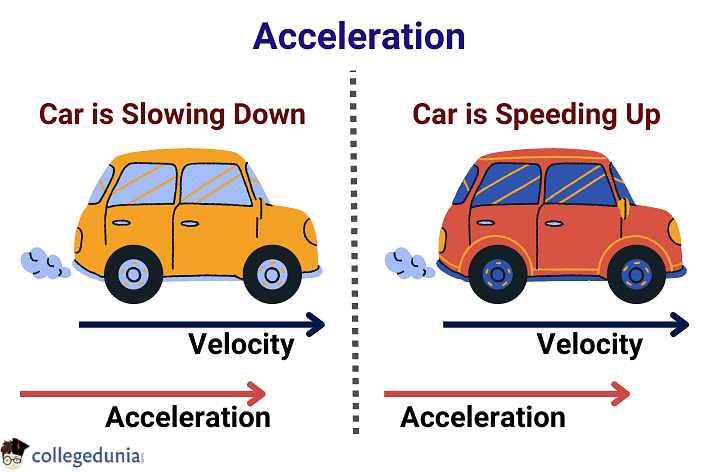
Acceleration
Acceleration Formula
[Click Here for Previous Years’ Questions]
Acceleration is equal to the difference between the initial and final velocities of an object divided by time. Thus, Acceleration Formula is given as follows:
| Acceleration = Change in Velocity / Time Taken |
Mathematically, the Acceleration Formula is given as:
| a = (v – u) / t |
Where
- a: Acceleration
- v: Final Velocity
- u: Initial Velocity
- t: Time Interval
Read More:
What is Uniform Acceleration?
[Click Here for Sample Questions]
Uniform Acceleration is defined as a type of acceleration in which the velocity of an object increases at a constant rate. In simpler terms, if an object has an equal amount of velocity in equal intervals of time, it is said to have uniform acceleration or uniformly-accelerated motion.
- Uniform Acceleration is generally witnessed in a rectilinear motion.
- The velocity-time graph of uniform acceleration is a straight line in which the slope gives the required acceleration.
Mathematically, Uniform Acceleration is given as:
| a = dv/dt |
Where
- a: Acceleration of Body
- dv: Rate of Change of Velocity
- dt: Rate of Change of Time
Uniform Acceleration Graph
The graph of uniform acceleration is a straight line. The slope of the graph gives the acceleration of the object. The velocity-time graph of acceleration is as follows:
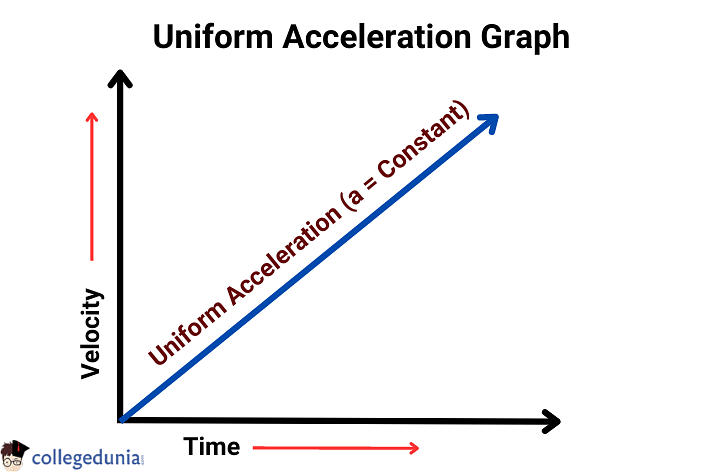
Uniform Acceleration Graph
Uniform Acceleration Examples
Here are some common examples of Uniform Acceleration:
- A bicycle rider riding a bicycle on a slope using both pedals.
- A ball or object rolling down the slope.
- A person sliding down from the slider in the park.
Motion in a Straight Line Detailed Video Lecture
Uniformly Accelerated Motion
[Click Here for Previous Years’ Questions]
When an object moves along a straight line and its velocity increases by equal amounts in equal intervals of time, then the motion of the object is called Uniformly Accelerated Motion.
- Uniformly Accelerated Motion occurs when an object moves in a straight line.
- The rate of change of velocity is constant in this motion.
- Thus, it can be said that Uniformly Accelerated Motion is a motion in a straight line.
Properties of Uniformly Accelerated Motion
Here are some important properties of Uniformly Accelerated Motion:
- When the velocity of an object increases with time, it is termed Positive Acceleration.
- When the velocity of an object decreases with time, it is termed Negative Acceleration or Retardation.
- When the velocity of the object is zero, it is termed Zero Acceleration.

Uniformly Accelerated Motion
Uniformly Accelerated Motion In A Plane
- Projectile Motion is the most popular example of motion in a plane with uniform acceleration.
- The only acceleration acting on the particle in projectile motion is the acceleration due to gravity (g).
- In a horizontal direction, the velocity in the x-direction will be constant as there is no acceleration.
- Thus, the equations of motion can be applied separately in two directions to get results.
Read More: Motion in a Straight Line Important Questions
Equations of Uniformly Accelerated Motion
[Click Here for Sample Questions]
There are three important equations of motion dealing with Uniform Acceleration or Motion in a Straight Line. They are as follows:
- v = u + at
- v2 = u2 + 2as
- \(\begin{array}{l}s = ut + \frac{1}{2}at^{2} \end{array}\)
Where
- v: Final Velocity of Object
- u: Initial Velocity of Object
- s: Displacement of Object
- a: Acceleration of Object
- t: Time Interval
Equations of Motion can be derived using the simple algebraic method, graphical method, and calculus method. The sign convention needs to be followed when using equations of motion in which one direction is considered to be positive and another one is taken as negative.
Read More: Derivation of Equation of Motion
What is Non-Uniform Acceleration?
[Click Here for Previous Years’ Questions]
Non-Uniform Acceleration is another type of acceleration along with Uniform Acceleration.
- If the velocity of an object changes by unequal amounts in equal intervals of time, the object is in non-uniform acceleration.
- The direction of velocity and the magnitude of the Acceleration changes with time in non-uniform acceleration.
- The velocity-time graph of non-uniform acceleration is a non-uniform curve.
- Examples of non-uniform acceleration include driving a car or bike on a curved path or in heavy traffic, etc.
Check More:
Difference Between Uniform and Non-Uniform Acceleration
[Click Here for Sample Questions]
Uniform Acceleration and Non-Uniform Acceleration are the two major types of Acceleration.
- Uniform Acceleration: If an equal amount of velocity increases in equal intervals of time, it is uniform acceleration.
- Non-Uniform Acceleration: If the velocity of the object changes by unequal amounts in equal intervals of time, it is non-uniform acceleration.
The key difference between Uniform and Non-Uniform Acceleration are as follows:
| Parameter | Uniform Acceleration | Non-Uniform Acceleration |
|---|---|---|
| Definition | If an object has an equal change in velocity over an equal period of time, it is said to have a uniform acceleration. | If the velocity of an object changes by uneven amounts in equal intervals of time, it is said to have non-uniform acceleration. |
| Graph | The graph of uniform acceleration is linear, i.e. a straight line. | The graph of uniform acceleration is a curved line. |
| Example | An object falling freely experiences uniform acceleration. | Circular Motion Patterns experience non-uniform acceleration in which the direction changes at each point but the speed remains constant. |
Motion in a Straight Line Class 11 Handwritten Notes
[Click Here for Previous Years’ Questions]
Here are the handwritten notes on Motion in a Straight Line and related concepts:





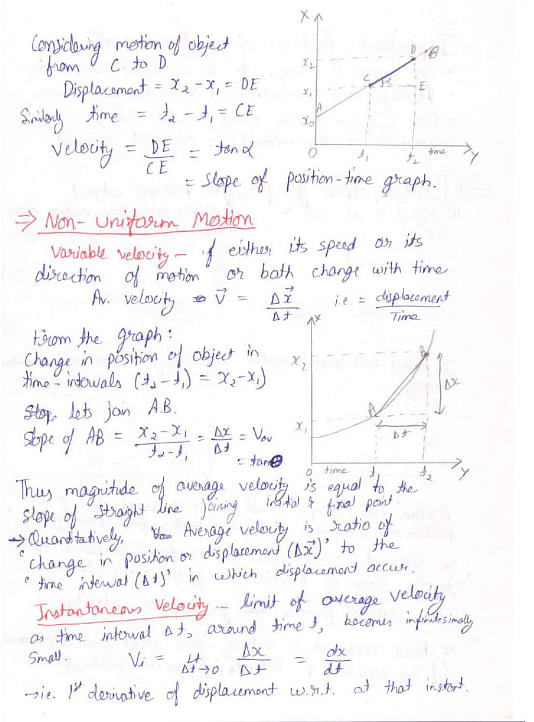


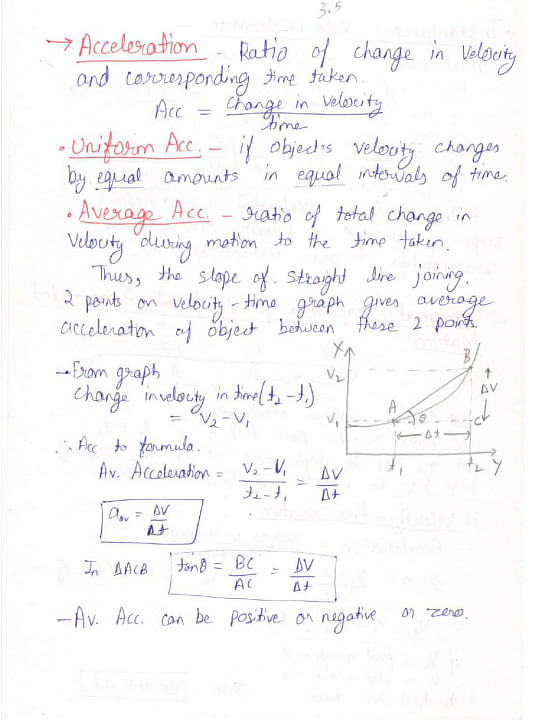
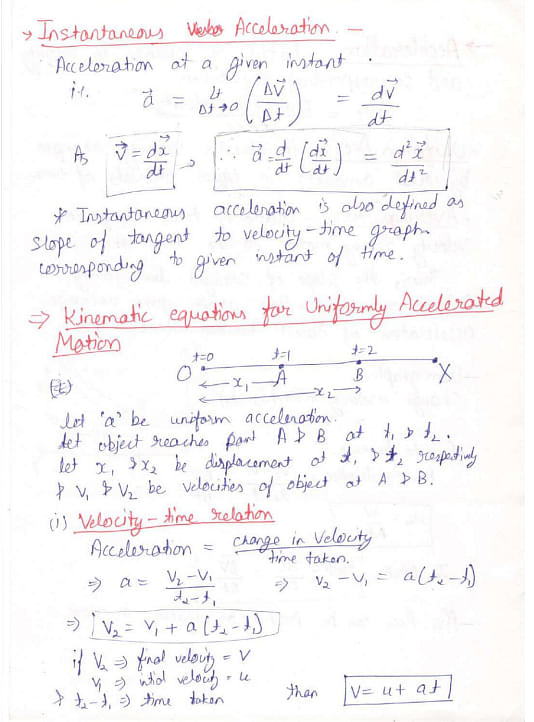
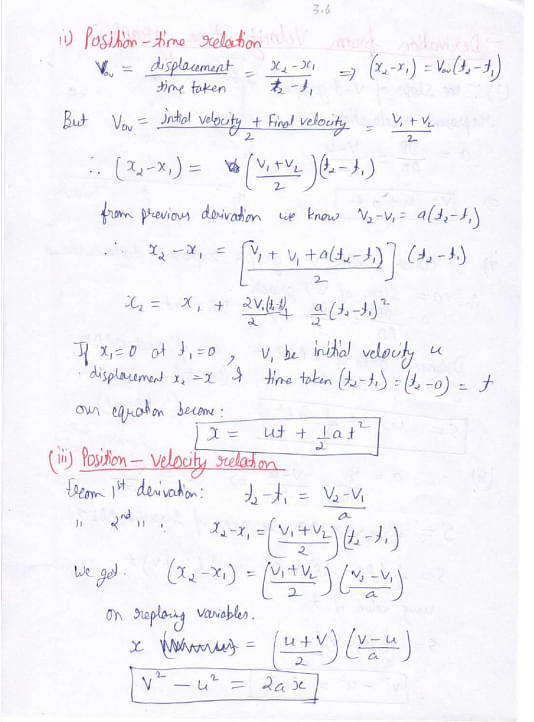
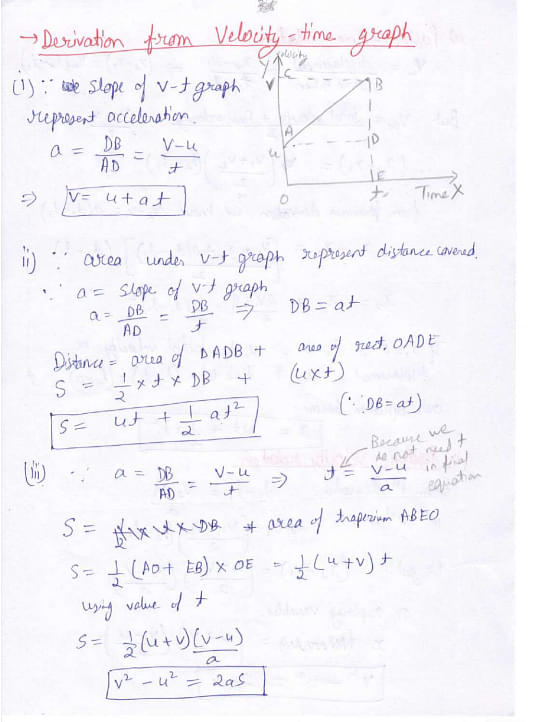
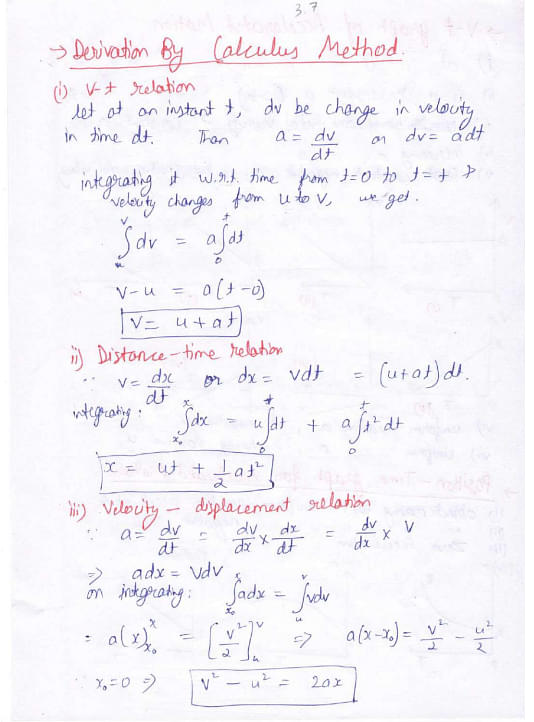



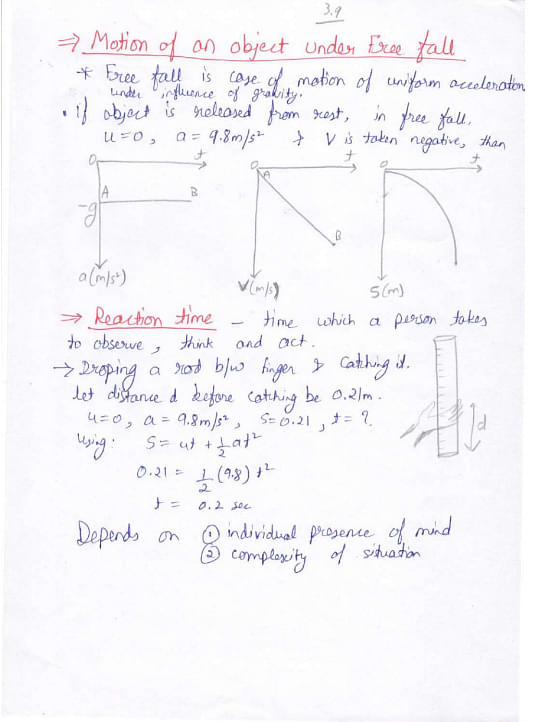
Things to Remember
- Acceleration is the rate of change of velocity with respect to time.
- Uniform Acceleration is a type of acceleration where the acceleration of an object remains constant throughout a given time.
- If an equal amount of velocity increases in equal intervals of time, the object is said to have Uniform Acceleration.
- The velocity-time graph of Uniform Acceleration is a straight line.
- Examples of Uniform Acceleration include a free-falling ball, a ball rolling down a slope, etc.
- Non-Uniform Acceleration occurs when the velocity of the object changes by unequal amounts in equal intervals of time.
Previous Years’ Questions
- At a metro station, a girl walks up a stationary escalator in… (KCET – 2020)
- A ball is thrown vertically downward with a velocity of 20m/s... (NEET – 2020)
- In a car race on a straight road, car A takes a time t less than car... (JEE Main – 2019)
- A person standing on an open ground hears the sound of a jet... (JEE Main – 2019)
- A passenger train of length 60 m travels at a speed of 80 km/hr. Another... (JEE Main – 2019)
- A particle starts from origin O from rest and moves with a uniform acceleration... (JEE Main – 2019)
- A particle shows distance-time curve as shown in the figure. The maximum... (KCET – 2018)
- A juggler keeps on moving four balls in the air throwing the balls after... (BITSAT – 2018)
- A man in a car at location Q on a straight highway is moving with speed... (JEE Main – 2018)
- Displacement x versus t2 graph is shown for a particle. The acceleration... (UPSEE – 2017)
Sample Questions
Ques. A car from rest travels a distance of 40 m at a constant acceleration of 20 m/s. How long does it take to cover the distance? (3 Marks)
Ans. Given that,
- Distance, s = 40 m
- Acceleration, a = 20 m/s
- Initial Velocity, u = 0 (Initial Position was Rest)
- Time, t =?
Using the Equations of Motion, we get
s = ut+(1/2)at2
s = (0)t + 0.5 x 20 x t2
40 = 0.5 x 20 x t2
40/(10) = t2
t2 = 4 = 2
Therefore, 2 seconds are required to cover a distance of 40m with an acceleration of 20m/s2.
Ques. A man starts at rest and travels a distance of 40 m in 4 secs. Determine the acceleration at which he travels. (3 Marks)
Ans. Given that,
- Distance, s = 40 m
- Initial Velocity, u = 0 (Initial Position was Rest)
- Time, t = 4 sec
- Acceleration, a =?
Using the Equations of Motion, we get
s = ut + (1/2)at2
40 = (0)t + 0.5 x a x 16
40 = 8a
a = 40/8
a = 5m/s2
Therefore, the man travels with a constant acceleration of 5m/s2.
Ques. Differentiate between Uniform and Non-Uniform Acceleration. (3 Marks)
Ans. The difference between Uniform and Non-Uniform Acceleration is as follows:
| Uniform Acceleration | Non-Uniform Acceleration |
|---|---|
| A body is said to have uniform acceleration if an equal amount of velocity increases in equal intervals of time. | A body is said to have a non-uniform acceleration if the velocity of the object changes by unequal amounts in equal intervals of time. |
| The velocity-time graph of uniform acceleration is a straight line. | The velocity-time graph of non-uniform acceleration is a curved line. |
| Example: A free-falling object possesses uniform acceleration. | Example: Objects in circular motion possess non-uniform acceleration. |
Ques. A body moves from rest and travels with a constant acceleration of 2 m/s2. Find its speed and distance after 5 secs. (3 Marks)
Ans. According to the question,
- Initial Velocity, u = 0 (Initial Position was Rest)
- Time, t = 5 sec
- Acceleration, a = 2 m/s2
- Distance, s =?
- Final velocity, v =?
Using the Equations of Motion, we get
v = u+ at
v = 0 + 2 x 5
v = 10 m/s
Thus, the final velocity is 10 m/s.
Substituting the value in another equation of motion, we get
S = ut + 0.5at2
S = (0)5 + 0.5 x 2 x 25
S = 25m
Thus, the body traveled at a speed of 10 m/s to a distance of 25 m.
Ques. A car begins at a speed of 3 m/s and accelerates at a rate of 2 m/s2 over a distance of 50 m. Find the final speed of the car. (3 Marks)
Ans. Given that,
- Initial Velocity, u = 3 m/s
- Acceleration, a = 2 m/s2
- Distance, s = 50 m
- Final velocity, v =?
Using the Equations of Motion, we get
v2 – u2 = 2as
v2 - 9 = 2 x 2 x 50
v2 = 200 + 9
v = 14.49 m/s
Thus, the final velocity of the car which begins at a speed of 3 m/s and accelerates at a rate of 2 m/s2 is 14.49 m/s.
Ques. State a few examples of Uniform Acceleration in daily life. (2 Marks)
Ans. Examples of Uniform Acceleration in daily life are:
- Ball rolling down from a slope.
- Sky driver jumping out of a plane.
- Bicycle when brakes are jammed.
- Ball dropped from a building.
Ques. A rocket attains a speed of 50 m/s in 5 seconds. What will be the distance covered by the rocket in this process? (3 Marks)
Ans. Given that,
- Initial Velocity, u = 0 m/s (Started From Rest)
- Time, t = 5 sec
- Final velocity, v = 50 m/s
- Distance, s =?
Using the first equation of motion,
v = u + at
50 =0 + (a)(5)
50 = 5a
a = 10 m/s2
Now, put the value of a in the third equation of motion,
v2 = u2 + 2as
502 = 0 + 2(10)s
2500 = 20s
125 m = s
Thus, the distance covered by the rocket to attain a speed of 50 m/s in 5 seconds is 125 m.
Ques. State the factors affecting Acceleration. (2 Marks)
Ans. There are two major factors affecting acceleration:
- Mass of the object.
- Amount of force applied to the object.
The acceleration of the object decreases with increased mass and increases with increased force.
Ques. What are the Equations of Uniformly Accelerated Motion? (2 Marks)
Ans. Uniform Acceleration Equations are three important equations used to find the related quantities in motion in a straight line. The three equations of motion are as follows:
- v = u + at
- v2 = u2 + 2as
- s = ut + (1/2)at2
Ques. What are Uniform and Non-Uniform Motion? (3 Marks)
Ans. Uniform Motion and Non-Uniform Motion are the two major types of motion in Physics.
- Uniform Motion is defined as the motion of an object in which the object travels in a straight line and its velocity remains constant. In this type of motion, the object covers equal distances in equal intervals of time.
- Non-Uniform Motion is defined as the motion of an object in which the object travels with varied speed. In this type of motion, the object does not cover the same distance in equal time intervals, irrespective of the time interval duration.
Check-Out:




Comments